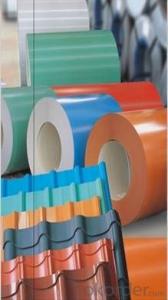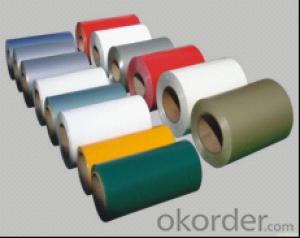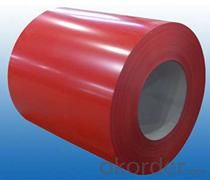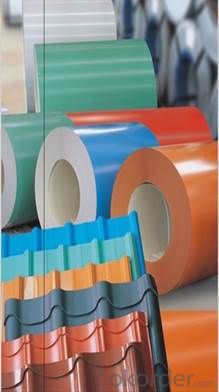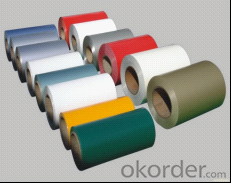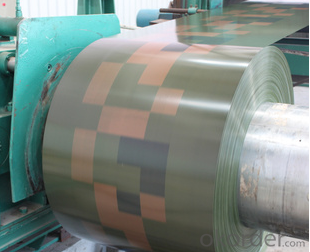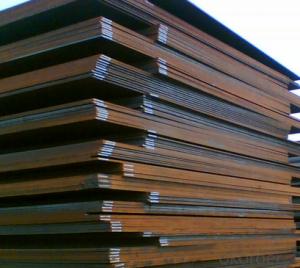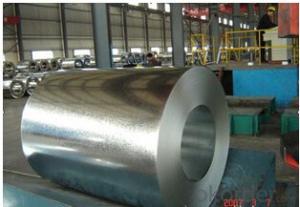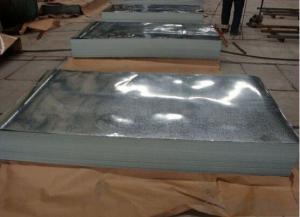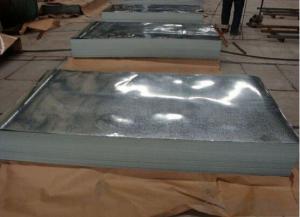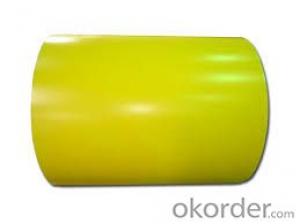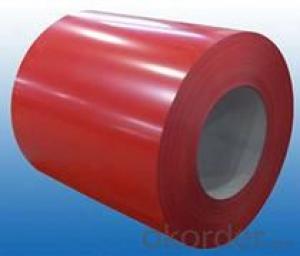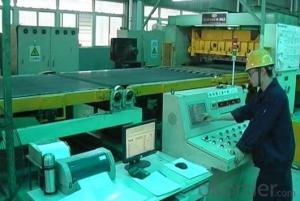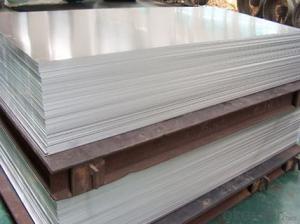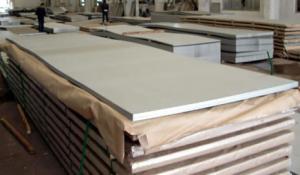Color coated galvanized Steel Coils/Sheets from China
- Loading Port:
- China main port
- Payment Terms:
- TT OR LC
- Min Order Qty:
- 1 m.t.
- Supply Capability:
- 100000000 m.t./month
OKorder Service Pledge
OKorder Financial Service
You Might Also Like
1) AVAILABLE DESIGNATION OF (Prepainted galvanized steel coils) printed PPGI coils
Quality Q/BQB 440-2003 JIS G3312-1994 EN 10326-2004 ASTM A653-02a
EN 10327-2004 (BASE PLATE)
(BASE PLATE)
Commercial Steel TDC51D CGCC DX51D+Z/AZ CS Type A/B/C
Forming Steel (TSt01,TSt02,TSt03) CGCD1 FS Type A, Type B
Drawing TDC52D /TDC53D - DX52D+Z/AZ DDS TYPE A/C
Steel DX53D+Z/AZ
Structural TS280GD(TStE28) CGC400 S280D+Z/AZ SS275
Steel TS350GD(TStE34) CGC440 S350D+Z/AZ SS340 Class1
2) OUR SPECIFICATION OF (Prepainted galvanized steel coils) printed PPGI coils
Available Size:
Manufacturer Thickness Width Length of plate Inner diameter of coil
JIANGSU HUIYE STEEL SHEET CO.,LTD 0.2-1.2mm 800/914/1000/1200/1219/1250mm 1000-6000mm 508mm/610mm
Coated Mass OF (Prepainted galvanized steel coils) printed PPGI coils:
Base plate Available Coated Mass(g/m^2)
Galvanized Steel 80, 100, 120, 160, 180
Galvalume Steel 50, 70, 150
Available Painting OF (Prepainted galvanized steel coils) printed PPGI coils:
Category of Painting Item Code
Polyester PE
High-durability polyester HDP
Silicon modified polyesters SMP
Polyvinylidene fluoride PVDF
Easy-Cleaning —
Painting Thickness Top side: 20+5microns;
Bottom side: 5~7microns.
Color System Produce according to RAL Color System or as per buyer’s color sample.
Painting structure Top surface Bottom surface
Primer coating No coating 1/0
Primer coating Primer coating 1/1
Primer coating + Finish coating No coating 2/0
Primer coating + Finish coating Primer coating or single back coating 2/1
Primer coating + Finish coating Primer coating + Finish back coating 2/2
- Q: What is the average fire rating for steel sheets?
- The average fire rating for steel sheets can vary depending on various factors, such as the thickness of the sheet, the type of steel used, and the specific fire testing standards that are being followed. Typically, steel sheets have a fire rating ranging from 30 minutes to 2 hours. However, it is important to note that fire ratings can be enhanced by incorporating additional fire-resistant materials or by using fire-resistant coatings on the steel sheets. It is always recommended to consult with fire safety experts or refer to the specific fire testing standards to determine the exact fire rating for a particular type of steel sheet.
- Q: Can steel sheets be used in corrosive environments like saltwater?
- Yes, steel sheets can be used in corrosive environments like saltwater. However, the type of steel and the level of corrosion resistance it offers will determine its suitability for such conditions. Stainless steel, for example, is highly resistant to corrosion and is often used in marine and saltwater environments. It contains chromium, which forms a protective layer on the surface of the steel, preventing it from reacting with the saltwater. Other types of steel, such as carbon steel, may also be used in saltwater environments, but they require additional protective coatings or treatments to prevent corrosion. Regular maintenance and proper care are essential to ensure the longevity of steel sheets in corrosive environments like saltwater.
- Q: What are the different types of finishes available for steel sheets?
- Steel sheets come in a variety of finishes, each with its own unique properties and visual appeal. Some commonly used finishes include: 1. Mill Finish: This is the standard finish achieved during the manufacturing process. It has a rough, dull appearance with visible imperfections. 2. Hot Rolled Finish: By subjecting the steel sheet to high temperatures during manufacturing, a scaly and rough surface is created. This finish is often used for structural purposes where appearance is not the main concern. 3. Cold Rolled Finish: The steel sheet is cold rolled to create a smooth and matte appearance. This finish is commonly used for applications that require a uniform and clean surface, like automotive panels or appliances. 4. Galvanized Finish: Through a process called galvanization, a layer of zinc is applied to the steel sheet. This finish offers excellent corrosion resistance and is often used for outdoor applications like roofing or fencing. 5. Electroplated Finish: A thin layer of metal, such as chromium or nickel, is electroplated onto the steel sheet. This finish improves corrosion resistance, enhances aesthetics, and can be available in different colors. 6. Powder-Coated Finish: Dry powder coating is applied to the steel sheet and then cured with heat. This finish provides durability, attractive appearance, and comes in various color options. It also offers excellent corrosion resistance. 7. Brushed Finish: The surface of the steel sheet is brushed with an abrasive material, creating a distinct brushed pattern. This finish is commonly used for decorative purposes, like architectural elements or kitchen appliances. 8. Polished Finish: The steel sheet is polished to achieve a smooth and reflective surface. This finish is often used for decorative applications that require a high level of aesthetics, such as ornamental pieces or jewelry. In conclusion, the choice of finish for steel sheets depends on specific requirements like durability, corrosion resistance, aesthetics, and cost.
- Q: How much is 2 millimeters per square meter?
- With the development of science and technology and industry, put forward higher requirements on the materials, such as high strength, high temperature, high pressure, low temperature, corrosion resistance, wear and other special physical and chemical properties, carbon steel has not fully meet the requirements.
- Q: Are steel sheets suitable for automotive chassis?
- Yes, steel sheets are suitable for automotive chassis. Steel is a popular choice for automotive chassis due to its strength, durability, and affordability. It provides excellent structural integrity and can withstand the various forces and stresses experienced by a vehicle during operation. Steel sheets also offer good resistance to impacts, vibrations, and corrosion, making them ideal for use in automotive chassis. Additionally, steel is a readily available material and can be easily formed, welded, and molded into different shapes and sizes, allowing for flexibility in design and manufacturing processes. Overall, steel sheets are a reliable and widely used material in the automotive industry for constructing chassis that meet the required safety, performance, and longevity standards.
- Q: How do steel sheets perform in high-pressure applications?
- Steel sheets perform well in high-pressure applications due to their high strength and durability. They are able to withstand the force exerted by the pressure, maintaining their structural integrity. Additionally, steel sheets have good resistance to deformation and can effectively distribute the pressure, reducing the risk of failure.
- Q: Are steel sheets resistant to impact damage?
- Yes, steel sheets are generally highly resistant to impact damage due to their strength and durability.
- Q: What is the process of electroplating steel sheets?
- The process of electroplating steel sheets involves immersing the steel sheets in an electrolyte solution containing metal ions. A direct current is then passed through the solution, causing the metal ions to be deposited onto the steel sheets, forming a thin layer of metal coating. This process helps improve the steel sheets' corrosion resistance, appearance, and other desired properties.
- Q: Can steel sheets be used for electrical transformers?
- No, steel sheets cannot be used for electrical transformers as they do not possess the necessary magnetic properties required for efficient transformer operation. Laminated iron cores are typically used in transformers to minimize energy losses and ensure proper magnetic flux.
- Q: What is the difference between stainless steel and regular steel sheets?
- Stainless steel and regular steel sheets differ primarily in their composition and properties. Stainless steel is an alloy made from a combination of iron, chromium, and other elements such as nickel and molybdenum. Regular steel, on the other hand, is primarily composed of iron with small amounts of carbon and other impurities. The key difference between stainless steel and regular steel sheets lies in their corrosion resistance. Stainless steel is highly resistant to corrosion due to the presence of chromium, which forms a protective layer on its surface when exposed to oxygen. This layer, known as a passive film, prevents the steel from rusting and makes it suitable for applications in environments with high moisture or chemical exposure. Regular steel sheets, on the other hand, are prone to corrosion as they lack the protective chromium layer. They may require additional coatings or treatments to enhance their corrosion resistance. Without proper protection, regular steel sheets can rust and deteriorate over time when exposed to moisture or corrosive substances. Another difference between stainless steel and regular steel sheets is their strength and hardness. Stainless steel is generally stronger and more durable than regular steel due to its alloy composition. It can withstand higher temperatures and has better resistance to wear and tear. Regular steel, although strong, may not offer the same level of strength and durability as stainless steel. The aesthetic appeal is another contrasting factor between the two. Stainless steel sheets have a shiny, reflective surface that gives them a modern and sleek appearance. They are often used in architectural and decorative applications where visual appeal is desired. Regular steel sheets, on the other hand, have a more dull and matte finish and are primarily used for structural and industrial purposes rather than for their visual appeal. In summary, stainless steel sheets offer superior corrosion resistance, strength, and aesthetic appeal compared to regular steel sheets. They are a preferred choice for applications where durability, hygiene, and maintenance-free performance are required, such as in kitchens, medical equipment, automotive parts, and construction projects. Regular steel sheets, while less expensive, may require additional protection and are commonly used in structural and industrial applications where corrosion resistance and visual appeal are not primary concerns.
Send your message to us
Color coated galvanized Steel Coils/Sheets from China
- Loading Port:
- China main port
- Payment Terms:
- TT OR LC
- Min Order Qty:
- 1 m.t.
- Supply Capability:
- 100000000 m.t./month
OKorder Service Pledge
OKorder Financial Service
Similar products
Hot products
Hot Searches
Related keywords

